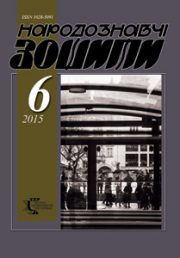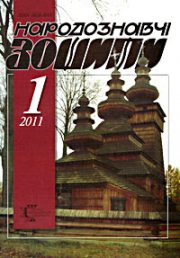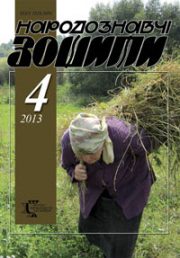The Ethnology Notebooks. 2022. № 4 (166), 868—875
UDK 392.1(=161.2)
DOI https://doi.org/10.15407/nz2022.04.868
CHANGE OF STATUSES AND FUNCTIONS OF THE PARTICIPANTS OF UKRAINIAN MATERNITY RITES
KUKHARENKO Oleksandr
- ORCID ID: https://orcid.org/0000-0001-5421-1004
- Candidate of Philological Sciences, Associate Professor,
- Associate Professor of the Kharkiv State Academy of Culture,
- 4, Bursatsky Descent, 61000, Kharkiv, Ukraine,
- Contacts: e-mail: art-red@ukr.net
Abstract. The article is devoted to the study of changes in the social status of the main participants in maternity rites: a pregnant woman, who as a result of ritual actions becomes a woman in labor and a mother, an old woman — a midwife, fellow villagers — godparents. Drawing parallels with changes in the statuses of other cycles of family rites — wedding and funeral, the researcher concludes that the birth cycle is also divided into four stages, which are determined by the social status of the protagonist: unborn — born — baby — child. The border rites, in which the transitions to the next stages and statuses in the structure of the cycle are carried out, were three rites — act of delivery, naming and baptism; or rather — the culminating episodes of these rites.
In the example of the rite of first haircut, it seems plausible to assume that at the end of the previous rite, access to the source of sacralization from the afterlife is terminated and resumed at the beginning of the next. As a result, first haircut that takes place one year after the main cycle of the nine rites have been excluded from the established structure of maternity rites. The rite of first haircut is aimed only at returning to the events of a year ago and to the event of birth, which is an integral episode of the delivery rite.
A necessary condition for the development of ritual action should be the presence of conflict, which is a confrontation and arises between antinomic oppositions male — female, culture nature, reality — afterlife, and is realized in the actions of opposing characters, mutual influences between venues (with the sacred center and without it), things and subjects used in rituals.
Important for the development of ritual action are the characters-mediators, who give impetus to further events in clearly defined mediative episodes. The study revealed an interesting pattern: the entrance to the rite in the first three rituals of the cycle is carried out by mediators — a woman, a man and an old woman, and the exit — a midwife, a father and a mother. These are the same characters, but in the first case — before obtaining new social statuses, and in the second — after that.
The topicality and scientific novelty of the topic are determined by a combination of thematic directions: on the one hand, family rites, in particular funeral ones, on the other hand, the expediency of implementing an ethnological approach in coordination with the structural-functional method of research, which constitutes a progressive and effective methodology for studying objects of national tradition.
Keywords: Ukrainian ritualism, family rites, maternity rite, rites of transitions, antinomy, mediation.
Received 23.08.2022
REFERENCES
- Gennep, A. van. (1999). Rites of passage. Systematic study of rituals. Moscow [in Russian].
- Kukharenko, O.O. (2016). Criteria for dividing the structure of wedding ceremonies. The Paradigm of Cognition: humanitarian Issues, 8, 36—49 [in Ukrainian].
- Kukharenko, O. (2018). Funeral Ceremony in the System of Structural-Functional Studies of Family Objectives. Paradigm of Knowledge. Multidisciplinary Scientific Journal. Muscat, 2, 132—144.
- Baiburin, A.K. (1993). Ritual in Traditional Culture: Structural and Semantic Analysis of East Slavic Rites. St. Petersburg[in Russian].
- Voropai, O.I. (1993). Customs of our people. Kyiv: Amulet [in Ukrainian].
- Propp, V.Ya. (2000). The historical roots of the fairy tale. Moscow: Labyrinth [in Russian].
- Levi-Strauss, K. (1985). Structural Anthropology. Moscow [in Russian].
- Kukharenko, O.O., & Kukharenko, A.V. (2019). Aims of ritual ceremonies and determining nature of the actions of episodes in the structure of the cycle of national wedding ceremonies. Art Notes: A Collection of Scientific Papers (Issue 35, pp. 22—27) [in Ukrainian].







